Hypericum – St John’s Wort, Rose of Sharon, Aaron’s Beard
Make your garden feel a lot better with this cure all….

Hypericum is a large family of perennial shrubs with creeping roots. This specimen is three feet tall and attracts lots of insects from mid June. Often called St John’s Wort it is named after St John’s day which is 24th June when it’s flowers are collected for medicinal purposes.
In mild climates the shrub can be evergreen with glossy leaves. With several varieties having an award of garden merit this is a shrub that is well worth growing.
Flowers and Cultivation
- The single yellow flowers are often quite numerous as on this Hidcote variety. It is also known as the Rose of Sharon.
- Flower colour varies from pale lemon yellow to an umber or burnt orange-yellow
- There are 5 petals and a large number of stamen leading to another common name Aaron’s Beard.
- They flower at the end of branches or stems and create a spicy scent of curry.
- After the flowers there are fleshy red berries that contain numerous seeds
- The wild flower can be quite invasive spreading by roots or seeds dropped by birds
- Prune after flowering. They can stand a hard cut back and may even benefit.
- Grow the ground cover Hypericum calycinium Briggadoon which can flower July -October
Herbal and Medicinal Uses
- St. John’s Wort has been used for centuries to treat mental disorders and nerve pain. The flowering tops are used to prepare teas.
- Today, St. John’s Wort is used by some for depression, anxiety, and sleep disorders as well as a balm for wounds, burns, and insect bites.
- St John’s Wort contains lots of active ingredients including hypercin and hyperfloin and should be purchased in liquid or tablet form so the dose level is known and controlled.
- Photosensitivity and sunburn can be caused to users and it is not recommended for pregnant women
Other varieties to try
- H. beanii with graceful arching stems it is a parent to many varieties
- H. olympicum appropriate name for an Olympic year. AGM plant
- AGM versions of Hypericum include forrestii, moserianum, kouytchense, roeperianum ‘Rowallane’ and uniflorum ‘Citrinum’.
- Another one for the Olympics is H chinense hinting where many Hypericums originate.
